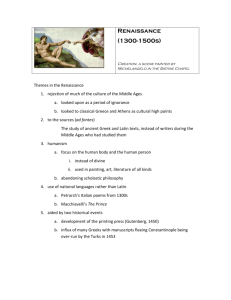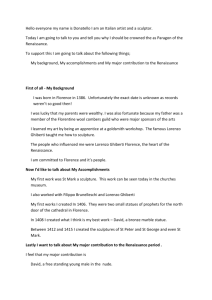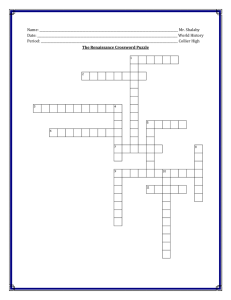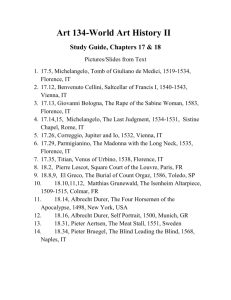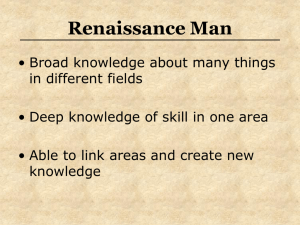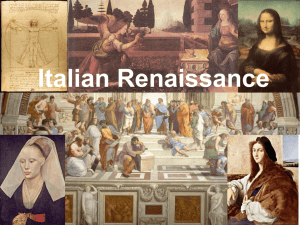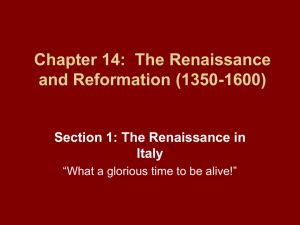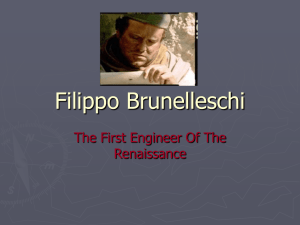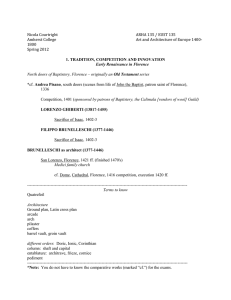Handout- Review for Exam 1
advertisement
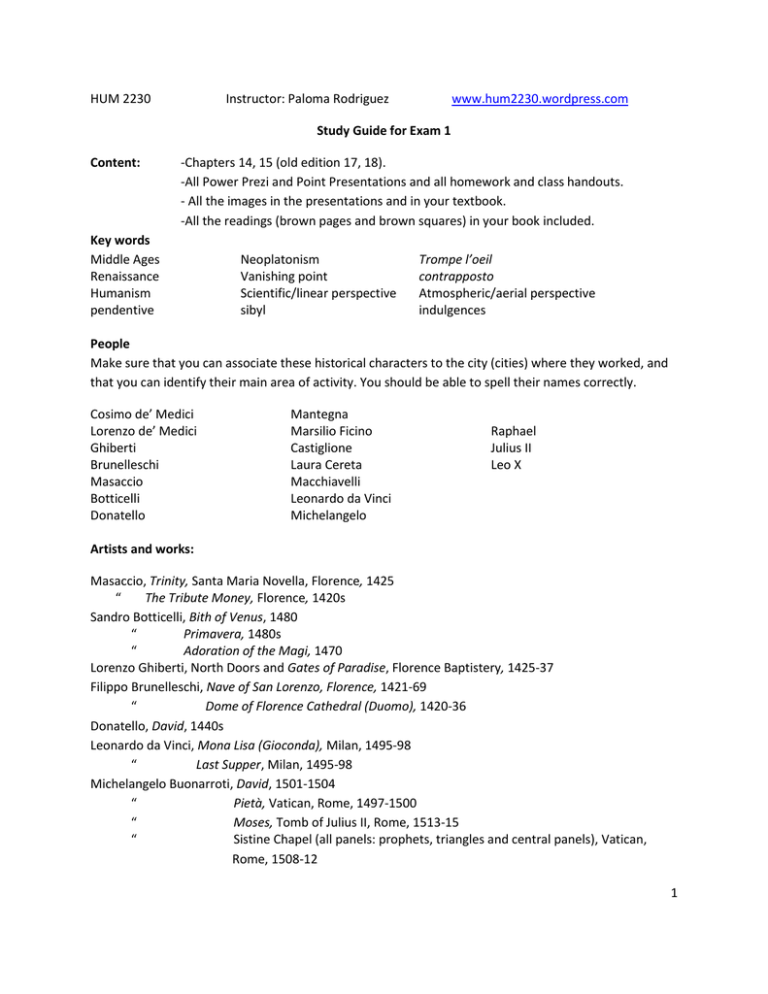
HUM 2230 Instructor: Paloma Rodriguez www.hum2230.wordpress.com Study Guide for Exam 1 Content: -Chapters 14, 15 (old edition 17, 18). -All Power Prezi and Point Presentations and all homework and class handouts. - All the images in the presentations and in your textbook. -All the readings (brown pages and brown squares) in your book included. Key words Middle Ages Renaissance Humanism pendentive Neoplatonism Vanishing point Scientific/linear perspective sibyl Trompe l’oeil contrapposto Atmospheric/aerial perspective indulgences People Make sure that you can associate these historical characters to the city (cities) where they worked, and that you can identify their main area of activity. You should be able to spell their names correctly. Cosimo de’ Medici Lorenzo de’ Medici Ghiberti Brunelleschi Masaccio Botticelli Donatello Mantegna Marsilio Ficino Castiglione Laura Cereta Macchiavelli Leonardo da Vinci Michelangelo Raphael Julius II Leo X Artists and works: Masaccio, Trinity, Santa Maria Novella, Florence, 1425 “ The Tribute Money, Florence, 1420s Sandro Botticelli, Bith of Venus, 1480 “ Primavera, 1480s “ Adoration of the Magi, 1470 Lorenzo Ghiberti, North Doors and Gates of Paradise, Florence Baptistery, 1425-37 Filippo Brunelleschi, Nave of San Lorenzo, Florence, 1421-69 “ Dome of Florence Cathedral (Duomo), 1420-36 Donatello, David, 1440s Leonardo da Vinci, Mona Lisa (Gioconda), Milan, 1495-98 “ Last Supper, Milan, 1495-98 Michelangelo Buonarroti, David, 1501-1504 “ Pietà, Vatican, Rome, 1497-1500 “ Moses, Tomb of Julius II, Rome, 1513-15 “ Sistine Chapel (all panels: prophets, triangles and central panels), Vatican, Rome, 1508-12 1 Raphael, School of Athens, Stanza dell Segnatura, Vatican, Rome, 1510-11 Literature: Boccaccio Decameron (the Plague) Plato Allegory of the Cave Niccolo Macchiavelli, The Prince (Il Principe) Baldassare Castiglione The Book of the Courtier Giorgio Vasari, Lives of the Most Excellent Painters, Architects and Sculptors Other Buildings: Palazzo Medici-Riccardi, Florence, 1444 Laurentian Library, 1525-71 The Pantheon, Rome, 118-125 CE Topics for the essay questions 1. The Dark Ages. Important events from the Fall of the Roman Empire to the beginning of the Renaissance. a. Plague, war, cultural decline. See Prezi and Boccaccio’s Decameron (the Plague). b. Contrast between the Islamic Empire and Western Europe during the Middle Ages. The contributions of the Islamic empire. Be ready to discuss the documentaries about the Islamic empire. c. Access to knowledge in the Middle Ages: monasteries as repositories of knowledge, Christianity and censorship, attitudes towards the Classical World, attitudes toward science. d. Be prepared to discuss the movie “The Name of the Rose” 2. From the Medieval mind to the Renaissance. Explain the changes and evolution of ideas from the late Middle Ages into the Renaissance. Discuss the importance of the Classical World during the Renaissance and provide specific examples of its revival during the Renaissance (themes, iconography, religion, artistic models…). 3. Florence and the Medici. Explain who the Medici were, his family landmarks (business, dwelling, religious/ civic representation) and his role as patrons of the arts. Name works they commissioned, artists who worked for them, cultural achievements, views on learning and the transmission of knowledge, and explain their personal views (philosophy…). 4. The Sistine chapel. General structure, history and use. The ceiling: author, structure, themes, and philosophical (Neoplatonic) reading of the frescoes. 2 Practice exercises Geography A. Situate the following cities in the map: Florence, Venice, Rome. Color their areas of influence during the Renaissance. B. Situate the following landmarks in the city in which they are located (some are in Venice. Study them as well) Piazza della Signoria Piazza di San Marco Piazza di San Pietro Santa Maria del Fiore (duomo) Florence Loggia della Signoria Ponte Vecchio Grand Canal Ca’ d’Oro Palazzo Medici-Ricardi Palazzo Ducale (doge’s) Arno River Pantheon Rome Saint Peter’s Basilica Saint Marks’s Basilica Tiber River Sistine Chapel Venice 3 Practice 1. Fill in the blanks. If in doubt you can look at the list of names provided above. a. The sculptor of the Gates of Paradise in Florence Baptistery __________________________ b. He sculpted the tomb of pope Julius II as well as a Pietà __________________________ c. He was the architect who designed the Villa la Rotunda __________________________ d. He painted Primavera and the Birth of Venus __________________________________ e. He designed the renovation of Saint Peter’s Basilica ____________________________ f. He painted a ceiling simulating an opening where people look down into a room ________________________ g. He sculpted the first freestanding nude since antiquity _______________________ h. He wrote a famous book of manners ___________________________ i. Famous patron of the arts and humanist _________________________ j. Painter of the Stanza della Segnatura _____________________________ k. Patriarch of a wealthy family of bankers from the city of Florence __________________________________ l. He wrote a pioneering text in political science _______________________________ m. Author of a letter addressing defending the ability of women to engage in intellectual matters. _____________________ ______ n. He preferred aerial perspective to linear perspective and focused on the psychological traits of the people he portrayed. ____________________________________ o. He was the first painter to use scientific and aerial perspective ________________________ 2. True or False a. _____ Neoplatonic philosophers think that the human soul has the potential of becoming divine. b. _____ Leonardo’s Last Supper does not make use of scientific perspective. c. _____ During the Renaissance it is not uncommon to see pagan gods depicted. d. _____ The population of Rome was larger during the Renaissance than in Ancient times. e. _____ The ancient buildings of Rome were in a state of disrepair during the Renaissance. f. _____ The renovation of Saint Peter’s Basilica was financed through the sale of the Church property and works of art. g. _____ The ancient goddess Venus became the epitome of platonic ideals (love, truth (knowledge) and beauty) for the artists of the Renaissance. 4
